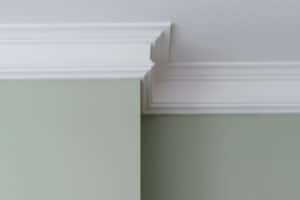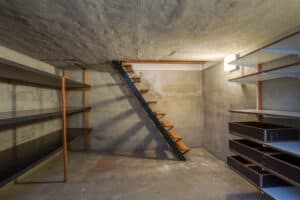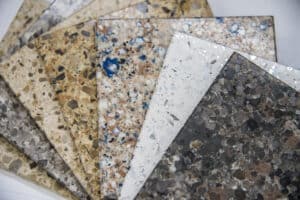
When shopping for countertops or sink basins, you might encounter polymarble.
The name suggests that it may be a variant of marble, but you may not be sure.
Here’s everything we’ve learned about polymarble and its uses.
What Is Polymarble?

Polymarble is a type of material that’s treated for use in countertops and sink basins.
It’s used as a competitor to porcelain, natural stone, and similar types of materials.
At its heart, polymarble is a calcium carbonate core that has a gel coating of polyurethane resin.
Fillers are also added to the mixture to make it more durable and resistant to scratches and stains.
It’s often used to create countertops, shower basins, and sink basins.
What Are Some Of The Features Of Polymarble?

There are a few features of polymarble that make it a great choice for shower basins, sink basins, and countertops.
Here are some of those features.
1. Durability

One of the reasons many homeowners turn to polymarble over other materials is its durability.
Polymarble is 2 mm thick.
That makes it difficult to damage.
While chipping is always possible, it takes considerably more effort to scratch or dent its surface.
Using it in a shower basin makes sense because a lot of damage can occur there.
Dropping soap, shampoo, and even razors is a common occurrence.
Softer or thinner materials may scratch or break entirely.
That isn’t the case with polymarble.
It will withstand most types of damage and last a long time.
2. Stain And Chemical Resistant

Another reason many homeowners are switching to polymarble is that it’s resistant to a lot of things.
One of those is stains.
In the shower and sink, stains can be unsightly to behold.
No matter how much scrubbing you do, certain stains like soap scum won’t disappear.
This isn’t a problem with polymarble.
As long as you maintain its surface, you don’t have to worry about stains leaving a mark.
The same goes for stains that come from calcium buildup, rust, or other types of stains.
You can easily clean them up and notice a shiny and new appearance beneath them.
The other thing that polymarble is resistant to is chemicals.
With some materials, the presence of chemicals can wear them down.
The molecules interact with the material and cause them to degrade.
That isn’t the case with polymarble.
Its molecules don’t interact with chemicals.
It retains its shape, color, and conformity.
That makes using chemicals to clean the material safe and easy.
Since you can use almost any kind of chemical on it, polymarble is easy to maintain.
3. Minimal Porosity

One of the best features of polymarble is that it has minimal porosity.
That means it’s harder for things like bacteria and mold to penetrate its surface.
That’s important when it comes to keeping your sink or shower sanitized.
Showers, especially, are always under threat of mold growth.
Some types of materials can absorb the mold and make it easy for mold to grow and spread.
Removing it from the surface is difficult because the mold is practically within the material.
That isn’t the case with polymarble.
Mold and bacteria stay on the surface where you can clean them.
By staying on the surface, it’s difficult for mold to spread.
Keep in mind that your polymarble likely connects to other materials in your shower.
Mold and bacteria can still grow and spread in these areas, including reaching your polymarble.
With your polymarble, at least, you never have to worry about the mold or bacteria burying deeper within the material.
4. Easy To Maintain

Polymarble is incredibly easy to maintain.
Since you don’t need to worry about using chemicals on it, you can use almost anything to clean it.
You don’t need to have it stained every year either like marble.
At most, you can buff certain areas that have scuffs.
A simple buffing service can restore its gleam and make it look brand new.
You can even restore chips.
When you don’t have the budget or time to keep maintaining your natural stone or porcelain, then polymarble is a great alternative.
5. Affordable

Compared to other types of materials that make up countertops, sink basins, and shower basins, polymarble is affordable.
Despite its affordability, it’s a high-quality material.
It can last for years and requires little maintenance throughout the years.
It’s a good investment to make for a homeowner who wants the same high-quality look of marble without its weaknesses.
What Are The Disadvantages Of Polymarble?

While polymarble has a ton of benefits and features, there are two disadvantages to it.
The first is heat.
Similar to marble, polymarble doesn’t hold up well against direct contact with hot objects.
Hot water is fine as long as it isn’t continuous.
It’s also unlikely that you’re going to be using hot water to the temperature that can start to degrade it.
The problem occurs when you put something like a hair straightener on top of the countertop.
Hair straighteners can reach extremely high temperatures.
They can scald the skin and damage your polymarble’s surface.
There are a few ways you can minimize damage to your polymarble by reducing its exposure to extreme temperatures.
Even being aware of yourself and the instruments you’re using can be beneficial.
The second disadvantage of polymarble is its ability to chip.
Because it’s made out of calcium carbonate, it is susceptible to chipping.
Sharp or blunt damage done at the right angle can cause little parts of it to chip off.
The good news is that because polymarble is naturally thick, the chip likely won’t keep you from being able to use the countertop or basin.
You can also fix the chip and restore the basin or countertop.
Being aware of your surroundings and handling your polymarble gently can prevent chips in the first place.
What’s The Difference Between Polymarble And Ceramic?

When it comes to deciding which material to use in the bathroom, ceramic is a common choice.
Porcelain is one of the variants of ceramic and is often used because of its durability and beauty.
Unfortunately, porcelain can also be expensive.
There are a few similarities between ceramic and polymarble.
One of them is that they’re both long-lasting.
They’re both durable to a degree and degrade slowly over time.
Another similarity is that they’re both beautiful.
The shining and bright appearance of both makes them a natural choice for smaller rooms like bathrooms.
The similarities end there, however.
Here are a few differences between polymarble and ceramic.
1. Heat Resistance

Ceramic is a better material when it comes to heat resistance.
It has actual heat resistance which means you can set hot objects on it without damaging the material overmuch.
This isn’t the case with polymarble.
The material will be damaged when exposed to hot objects.
That also means you don’t have to worry as much when using hot water with ceramic, either.
While hot water likely won’t affect polymarble that much, consistent exposure to the hot water could have an impact on its durability over time.
If you’re worried about hot temperatures, then ceramic may be a better material for you to use.
2. Durability

While both materials have great durability, polymarble has a slight edge over ceramic.
It’s thicker than ceramic which gives it better rigidity.
If you drop ceramic, then you can expect it to shatter into pieces.
If you drop polymarble, then at most it might chip where it hits the floor.
The thickness and rigidity of polymarble allow it to better handle certain types of damage.
If you want to ensure the material that makes up your countertop or shower basin is capable of withstanding damage, then polymarble is your best choice.
3. Weight

Both materials are heavy.
However, polymarble is the heavier of the two.
This becomes an important factor during installation.
If you want to use a polymarble shower basin, then you can expect your plumber to charge you more.
It takes more effort to carry and assemble that material than ceramic.
They may even need a special piece of equipment to haul it into your bathroom.
You can carry ceramic on your own or with another person.
It’s easier to install which means the installation cost is going to be lower.
If you don’t mind the extra cost to install polymarble, then it’s a great material to have in the bathroom.
Otherwise, you may want to choose ceramic for an easier installation process.
4. Size Availability

It’s surprising to think that slabs of stone don’t come in various sizes.
That’s exactly the case, however.
Polymarble is only available in certain sizes.
That’s because it’s still a relatively new material.
The problem here is that if you have a specific project in mind, you may not find a polymarble sheet that fits the size.
As a result, you’ll need to pay for a larger sheet than you want to cut it to the size that you need.
The opposite is true with ceramic.
Because ceramic is widely used around the world, it’s available in several different sizes.
You can pay for the exact amount that you need.
If you have the budget to spend, then polymarble is still a great option.
If you prefer simplicity and need to stick to a budget, then ceramic wins this round.
5. Maintenance

It takes less effort to maintain polymarble than ceramic.
If ceramic shatters, then there’s no way of fixing it.
If polymarble chips, then you can fix the chip.
Ceramic sometimes needs a deep cleaning to remove stains.
Polymarble doesn’t have that problem because it’s stain-resistant.
At most, you need to rebuff and refinish polymarble to make it look brand new.
Ceramic can age.
Polymarble can continue to look timeless.
If you want to make maintaining your countertops and basins easy, then you need to go with polymarble.
What’s The Difference Between Polymarble And Natural Stone?

The other main competitor to polymarble is natural stone.
Quartz and marble are some of the most popular natural stone types used to create countertops.
Because polymarble is similar to marble and quartz, the three share a lot of similarities.
They’re all scratch-resistant and give a luxurious appearance to the countertop.
However, there are some differences between them.
1. Cost

Natural stone is expensive.
High-end slabs can cost well beyond $10,000.
If the slab contains rare colors, then the price will only increase.
This is standard for any natural stone like quartz or marble.
Polymarble is cheaper.
That’s because it’s made out of relatively cheap materials.
Calcium carbonate becomes covered with a gel-coated resin that has pigments in it.
The result is a durable, unique, and eye-catching material.
It’s easy to create and offers many of the same benefits as natural stone.
If you want a gorgeous countertop without the price tag of marble or quartz, then polymarble is the best solution.
2. Heat Resistance

Most types of natural stone are heat-resistant.
Quartz and granite are among the best suited for resisting hot temperatures.
Marble, like polymarble, has minimal heat resistance.
If you place something hot on its surface, then you can expect the material to have damage.
To choose what material to use for your countertop, you need to figure out its primary use.
Is it only to hold tools and objects?
If so, then polymarble or marble is a better option.
If you intend to cook on it or bake, then you may want to choose quartz or granite.
You can set a hot pan directly on its surface without worry.
Knowing the countertop’s main use can help you choose the best material for you.
3. Durability

Both polymarble and natural stone have a natural resistance to scratching.
That makes both of them durable.
Polymarble is a bit more durable than natural stone because of its thickness.
If the natural stone gets hit hard enough or falls during the installation process, it can shatter.
Polymarble has a better chance of only chipping.
Once natural stone receives damage, you’re unlikely to be able to repair it.
You can repair polymarble.
Both can also take heavy impact damage, but polymarble is more likely to come out of it with only scuff marks.
There’s a chance natural stone might shatter.
If you want your countertop to last through your abuse, then polymarble is a better option for you.
How Do You Maintain Polymarble?

The key to maintaining polymarble’s glossy appearance is to prevent damage and buff it.
Here are a few tips you can use to maintain your polymarble.
1. Don’t Rest Hot Objects On Its Surface

The most likely damage that you can ever do to your polymarble is through heat.
There are a few things you can do to prevent heat damage.
The first is to avoid using hot objects near the material.
Use another type of material where you know you’ll need to set hot objects.
You can also put down a trivet or some other type of protective holder that can safely hold the hot object away from the material.
Keeping pans, hair straighteners, and even hairdryers off of the surface with a pad or holder is ideal.
A third way to protect its surface is to stain it.
Like marble, there are stains you can use that can give it a protective thermal layer.
This layer will absorb the heat instead and protect the material below it.
You’ll need to reapply the layer every year.
2. Use Non-Abrasive Soap And Water To Clean It

Although polymarble is chemical-resistant, you should still refrain from using heavy-duty detergents on it.
The best way to clean your polymarble is with non-abrasive soap and water.
Clean your polymarble weekly with something like dish soap or similar soap.
Then rinse it with water.
Thanks to its low porosity, you don’t have to worry about bacteria, food, or other debris leaking into the material.
3. Finish It Once A Year

Once every year, you should buff and finish the polymarble.
This will remove any blemishes and return your polymarble to its glossy appearance.
Your polymarble will look brand new when you’re done.
4. Repair Chips

Accidents happen and your polymarble may have a few chips.
You can repair them by using a gel resin, a catalyst to start the curing process, and titanium powder.
Using those materials, you can replace the chip and seal it in place.
Sand the area to make it flush with the rest of the polymarble.
Conclusion

Polymarble is an affordable material that is often used in bathrooms.
It’s scratch-resistant, chemical-resistant, and has low porosity which makes it easy to maintain.
It doesn’t do well with hot temperatures, but its thickness makes it durable.
Consider the information above to determine if polymarble is right for your needs.




Leave a Reply